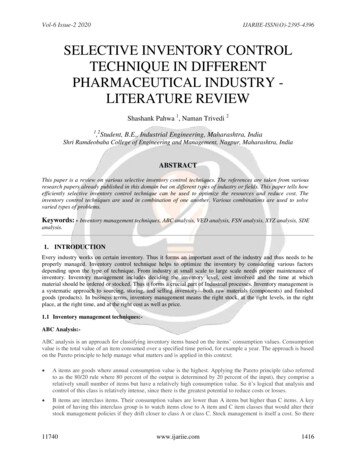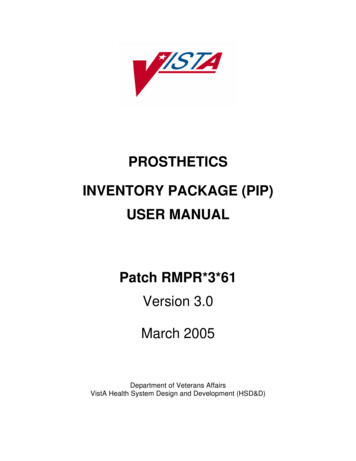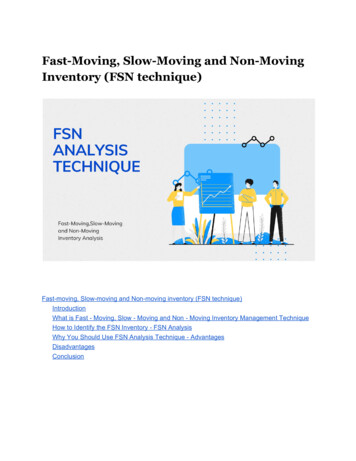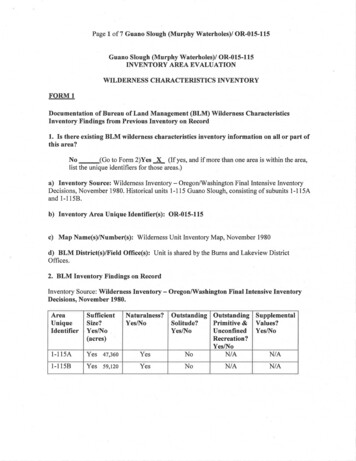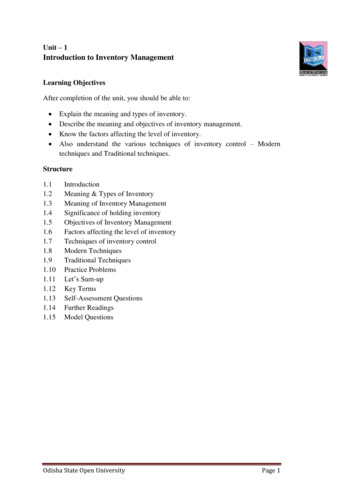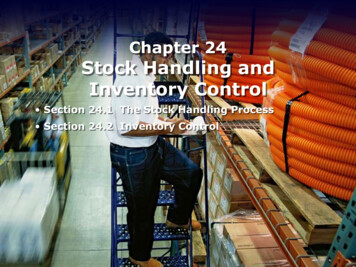
Transcription
Scientific Journal of Economics and Management ResearchVolume 3 Issue 3, 2021ISSN: 2688‐9323Research on Inventory Control in Supply Chain ManagementEnvironmentYongquan Zhao, Zhengkang Zhao*School of Economics and Management, Shanghai Maritime University, Shanghai 201306,ChinaAbstractWith the rapid development of the economy, cost is becoming more and more prominentin the automobile manufacturing industry, and inventory is becoming an important linkto reduce the cost of automobile manufacturing enterprises, and a more reasonablecontrol of inventory can enhance the competitiveness of enterprises and create moreprofits for them. In this paper, we firstly introduce the inventory control in the supplychain environment, then analyze the overall status of inventory control in China's automanufacturing industry, discuss the problems and causes, and finally analyze theconditions and methods of implementing zero inventory management in Toyota'sproduction method, and propose solutions for the inventory control problems in China'sauto manufacturing industry by combining Toyota's zero inventory management. In theend, we analyze the conditions and methods of implementing zero inventorymanagement under Toyota production method, and propose solutions to the problemsof inventory control in China's automobile manufacturing industry.KeywordsInventory Control; Zero Inventory Management; Automobile Manufacturing Industry;Toyota Production System.1. IntroductionInventory has the role of regulating production and sales. Once inventory control is notproperly controlled, it can cause great loss to the enterprise. For a company, inventory controlis about keeping inventory at a suitable level, which requires the company not to waste limitedstorage space by accumulating inventory, but also to maximize the market demand. Therefore,the key to inventory control is to use the most economical means to make the inventory meetthe market demand and at the same time reduce the cost and improve the overall efficiency ofthe enterprise. Therefore, theoretically and practically, we need to find out the problems in theimplementation of inventory control and propose solutions to strengthen the organizationalmanagement environment and help solve the negative effects of the lack of attention toinventory control, which is of great importance to promote the development of inventorycirculation and improve the overall efficiency and effectiveness of enterprises.Along with the ever‐changing science and technology and the continuous influence of economicglobalization, China's auto manufacturing industry is being suppressed and crowded out bymore and more powerful competitors. In order to ensure a lasting competitive posture,companies must make thoughtful and optimal consideration of inventory costs.However, for a long time, China's auto manufacturing companies have not been able toeradicate inventory, a problem that hinders the rapid development of the auto industry.Although many auto manufacturers have explored and learned from Toyota's zero inventorymanagement, in practice, they have not achieved significant success in inventory control due tothe lack of thorough knowledge and understanding of zero inventory. Therefore, an in‐depth428
Scientific Journal of Economics and Management ResearchVolume 3 Issue 3, 2021ISSN: 2688‐9323discussion of zero inventory management under Toyota production method, combined with theproblems and causes of inventory control in China's auto manufacturing industry, and theinspiration of inventory control in China's auto manufacturing industry according to Toyota'szero inventory management, can help enterprises reduce overall costs in the complicatedcompetitive environment, improve their core competitiveness and accelerate the pace of goingabroad.2. Overview of Inventory Control Methods in a Supply Chain ManagementEnvironment2.1.Supply ChainThe chain‐like structure formed by the horizontal integration of suppliers, intermediaries andend markets is called the supply chain. It encompasses the functions and structures of theinternal and external parts of the organization, which together form a value chain that providesgoods and services to the market. In this chain, not only manufacturers and suppliers arecovered, but also transporters, warehouses, distributors and markets. It is a kind of functionalnetwork chain that combines suppliers, manufacturers, distributors and the final market intoan integrated body around the core enterprise, starting from the purchase of raw materials tothe output of intermediate products and final products, and finally distributing goods toconsumers through sales agents. It is a value‐added chain that creates a comprehensivestructure for the whole chain. It is a value‐added chain that brings benefits to all the companiesin the supply chain.2.2.Inventory ControlGoods in storage are called inventory, which is a concrete expression of storage. Inventory in abroader sense also refers to products in the production and transportation states. It is simplyconsidered that inventory is the relevant products stored by a company for future sales.In terms of properties, the inventory of an enterprise has two aspects: on the one hand, theprerequisite for the production and processing of an enterprise is to have an inventory, withoutwhich the implementation of the enterprise's production plan would be put on hold; on theother hand, the inventory becomes a liability for the production and circulation of theenterprise, because the enterprise not only has to pay a lot of expenses for the storage of goods,but also has to suffer from the troubles caused by the loss and damage of the inventory.Theoretically, inventory is a waste, but in reality, it cannot be avoided. Inventories existbetween all parts of the business process and between all parts of the value chain of social andeconomic activities. It is the inventory that allows each link to be independent of each other'sactivities and makes the connection of each link and each sector a lubricant and a buffer. Thatis why it is said that inventory is the indispensable devil.Traditional inventory management conceptually considers inventory as a security andinventory materials as a valuable asset of the company, as stipulated by the current corporateaccounting standards. However, contemporary inventory management views inventory innormal operations as a waste and considers inventory materials as a burden to the business.Therefore, the management concept should emphasize the goal of zero inventory, hoping tofurther form a virtuous cycle of "reduce inventory expose the problems of the whole system improve the system more complete system further reduce inventory .". The virtuouscycle. In short, inventory control is to achieve "customer satisfaction and cost minimization",i.e., to satisfy customers and minimize costs at the same time. In view of this, some inventorycontrol methods and techniques are needed.429
Scientific Journal of Economics and Management ResearchVolume 3 Issue 3, 2021ISSN: 2688‐93232.3.Methods and Evaluation of Inventory Control in Supply Chain ManagementEnvironment2.3.1. Vendor Managed Inventory (VMI)1. Meaning of VMIVMI is a cooperative inventory control model between suppliers and their partners, in whichthe supplier manages the user's inventory under a system that is negotiated with the partnerin order to reduce the overall inventory cost. In addition, the supplier periodically monitors andcorrects the system for continuous improvement purposes. In short, the idea of VMI is that thesupplier builds inventory with the promise and help of the user, establishes inventory safetylevels and inventory replenishment, and enjoys the rights of inventory control.2. Steps of VMI implementation(1) Negotiate with the customer and obtain the cooperation intention of the other party. Thesupplier and the retailer negotiate and draft a contract, which covers ownership and transferstatute of limitations, credit terms, ordering terms, performance evaluation criteria, inventorylevels, etc.(2) Building a comprehensive information framework. In order to efficiently managecustomers' inventories, suppliers need to be able to grasp the real needs of end customers atall times. In view of this, it is necessary to go through an information link that should have thefunction of interconnecting the point‐of‐sale systems of retailers and suppliers so that they cancommunicate with each other in a timely manner.(3) Identify order processing steps and inventory control related data. The two parties shouldwork together to confirm the information and inventory data used by the supplier to processcustomer orders, standardize the order processing, and unify the ordering, delivery, andinvoice processing on the supplier side.(4) Continuous improvement. In the process of supplier management of partner's inventory,both parties work together to identify boards that can continue to be improved, and continueto correct the target structure in the process to achieve continuous improvement. Promotesustainable development of both parties.3. Evaluation of the implementation of the VMI modelThere are countless benefits of implementing VMI model, the most critical one is to reduce theadverse effects of "bullwhip effect". Under the VMI model, suppliers can collect the closestinformation to the end market through the retailer's POS system, and the strategy based on thiscan significantly reduce lead times and significantly improve service quality. In addition,suppliers can use VMI to reduce the instability of demand forecasts and better align productionwith distribution. In addition, it can provide a suitable opportunity to reinvent the retailer‐supplier relationship.There is no doubt that the VMI model will encounter some problems in the implementationprocess: the information system will take up a lot of investment; in addition, the process ofsharing information between retailers and suppliers may have the potential for misuse andleakage of information. In this way, suppliers will shoulder more responsibilities than beforeand the cost will rise, so it is especially important to build a mechanism to allocate equalbenefits and ensure the fair sharing of benefits.2.3.2. Joint Managed Inventory (JMI)Meaning of JMIJMI is a new type of partnership in which all nodes of the supply chain cooperate together tohighlight a win‐win partnership. Unlike VMI, JMI emphasizes joint participation in theformulation of inventory strategies to ensure the consistency and effectiveness of informationand forecasts among supply chain nodes, thus eliminating the "bullwhip effect". In this430
Scientific Journal of Economics and Management ResearchVolume 3 Issue 3, 2021ISSN: 2688‐9323management model, inventory control becomes the key to connect the two parties because thedetermination of commodity demand between neighboring nodes is the result of negotiationbetween them.Implementation method of JMI(1) Joint negotiation and unification of goals. To build a VMI model, it is necessary to ensurethat both parties have the same goals. To do so, we need to identify the points of agreement andcontradiction in market objectives, and through communication and negotiation, form a unifiedgoal under the principle of seeking common ground while reserving differences and mutualbenefit.(2) Establish the main content of inventory control. The joint inventory management center isresponsible for linking supply and demand and coordinating the interests of both. The effectiveoperation of this coordinating controller depends on a clear division of labor and cooperationbetween the two. Before that, the main elements of inventory control must be determined, suchas the coordination and distribution of inventory among different customers, maximum andminimum stock levels, safety stock levels, demand forecasting, etc.(3) Create a platform for information sharing and communication. Through informationtransfer and sharing among supply chain node enterprises, it can improve the transparency ofthe whole supply chain and reduce the instability in the process of supply chain operation, toachieve the purpose of reducing the overall inventory quantity and improving the efficiency oflogistics operation. In view of this, it is necessary to effectively use the advantages of networktools to build an advanced logistics information system.(4) Construct a reasonable benefit distribution mechanism and incentive mechanism. Tosuccessfully implement JMI, it is necessary to construct a fair benefit distribution entry andreasonably distribute the benefits implemented through supply chain management among thesupply chain member companies. In addition, a scientific incentive system can be adopted togive incentives to each enterprise involved in coordinated inventory management, so as toenhance the consistency and coordination of supply chain operation.Evaluation of JMICompared with the previous inventory control, joint inventory management has the followingadvantages.1. It ensures the synchronization and consistency of supply chain operations.2. Reduces the impact of the "bullwhip effect" in the supply chain and makes the supply chainoperation more reliable.3. As a bridge between suppliers and customers, inventory directly discloses problems in thesupplier management process and provides a factual basis for improving the continuous andeffective operation of the supply chain.4. it creates favorable conditions for the realization of zero inventory.In order to bring the utility of JMI into play, both the supply and demand sides should takemutual benefit and win‐win situation as the starting point, build a coordinated managementprogram, establish the goals and responsibilities of both sides, build a channel for informationcommunication, and propose more effective solutions for JMI control strategy.2.3.3. Just‐In‐Time (JIT) Production1. Meaning of JITJIT means just‐in‐time in Chinese. The basic principle of JIT is to determine supply by demand,i.e., the supplier will deliver the goods to the designated place according to the variety,specification, quantity, time and place required by the demander. No more and no less, noearlier and no later, and the quality of the delivered materials must be guaranteed.Implementation steps of JITJIT is a pull production method, i.e., reverse process, which starts with market demand and goesthrough: orders components accessories parts and raw materials, and inally to431
Scientific Journal of Economics and Management ResearchVolume 3 Issue 3, 2021ISSN: 2688‐9323suppliers. the key point of JIT is that each link of the company cooperates with each other,minimizing the amount of inventory and effectively improving the overall production efficiencyof the company.2. Evaluation of JITThe advantages of JIT are.(1) Minimizing the amount of inventory, reducing the capital employed by the enterprise interms of inventory, making the enterprise's capital turnover more flexible, and improving theenterprise's competitive vitality.(2) The high operating cost of inventory in terms of distribution is cut because it is picked upon demand.(3) Reduces the possibility of quality changes in inventory materials and products becomingunpopular with consumers due to obsolescence.(4) Avoidance of sudden changes in demand that would prevent many inventory items frombeing distributed to the market.(5) Reduces inspection and reworking time.However, since JIT is designed to reduce the amount of inventory, it does not have any surplusinventory, except for the scattered inventory of products that are rebuilt due to poor quality.Thus, if a company makes a mistake at any point in the production organization process, thereis no inventory available to remedy the situation; moreover, the manufacturer relies heavily onthe suppliers who provide the materials to the manufacturer, and if the suppliers are unable tomeet the deadline requested by the manufacturer, the manufacturer will not be able to produceaccording to the original production and processing plan. This disrupts the integrity of theentire production‐shipment process. It causes irreparable loss.3. Analysis of Inventory Control Problems in China's AutomotiveManufacturing Industry under the Supply Chain ManagementEnvironment3.1.The Current Situation of Inventory Control in China's Auto ManufacturingIndustryAlong with the rapid development of the global economy and the intensifying marketcompetition, exploring how to make enterprises enhance their core competitiveness andpromote the coordinated and orderly development of enterprises in the face of many rivals haslong been on the agenda of the head of enterprises. While the automobile manufacturingindustry is making great contribution to our economy, we must consider the inventory cost ofautomobiles. Inventory cost in the operation of each automobile manufacturing enterprises inthe prominent position cannot be overstated. The cost of inventory is inextricably linked to thepurchase of large and small parts and the manufacturing and welding of each component. Inview of this, companies are trying to control the inventory by all means.However, at this stage, China's auto manufacturing industry has not yet made significantachievements in terms of a complete inventory control system, nor has it yet applied advancedconcepts to explain the importance of inventory control. Most of the automobile manufacturingcompanies continue the traditional inventory control mode. However, this is not helpful to thelong‐term development of automobile manufacturing industry.3.2.Problems of Inventory Control in China's Auto Manufacturing Industry3.2.1. Lack of Overall Concept of Supply ChainAlthough the overall performance of the supply chain depends on the performance of the nodalenterprises in the chain, however, each node almost does its own thing and is independent, andthere are unilaterally set goals and tasks. Some goals are set inconsistently with the supply432
Scientific Journal of Economics and Management ResearchVolume 3 Issue 3, 2021ISSN: 2688‐9323chain, and some are even contradictory. This kind of self‐centered thinking is bound to bringtrouble to the overall efficiency of the supply chain.3.2.2. The Level of Information is not HighIn the supply chain, the forecast of the market, the condition of the warehouse and theproduction strategy are of extraordinary significance to each supply chain node enterprise. Theinformation is scattered among these related enterprises, and the enterprises must pass theinformation all the time if they want to achieve an efficient response to the market needs. Forthis reason, changes need to be made to the information system of the supply chain, so that theinventory information in the supply chain can be shared out adequately, effectively and quickly.However, most domestic automotive manufacturing companies do not currently integrate theinformation systems they have, which inevitably results in delays and inaccurate informationentries in the information systems. This results in a situation of information errors, whichaffects the accuracy of the calculation of inventory quantities.3.2.3. Simplicity of Inventory Management StrategiesMost of the companies are using the old single inventory control strategy, and the informationthey receive is mostly from within the organization, and the inventory control implementedunder this strategy does not fully reveal the core idea of supply chain management. In addition,when a company uses a single inventory control strategy for all inventory, the uncertaintybetween supply and demand is not reflected in a simple classification. Therefore, how todevelop an efficient inventory control strategy and reflect the core idea of supply chain hasbecome the main content of supply chain inventory control.3.2.4. Lack of Cooperation and CommunicationIn order to cope with the uncertainty of market needs, the relevant nodes of the supply chainare equipped with appropriate safety stocks, although setting safety stocks is a conservativestrategy for enterprises. However, in the globalized supply chain system, the unilateralcoordination of enterprises involves many stakeholder organizations, and each enterprise haslow information transparency. In the end, companies can only set safety stock at a high level,resulting in a low level of inventory control.3.2.5. Incomplete Quality of Management StaffThere are two goals of supply chain management, one is to reduce operation cost and the otheris to improve service quality. However, in most domestic enterprises today, because most oftheir energy is spent on finding resources and markets, they do not put the improvement ofservice level in an important position. The reason for this is that the management staff's ownmanagement level is not high enough and their management quality is not comprehensive, andtoo much interest in the heart eventually leads to insufficient market response and loworganizational evaluation, which makes it difficult to establish a strong competitiveness amongmany enterprises.4. Toyota Zero Inventory Management based on Supply Chain4.1.Toyota's Supply Chain ManagementToyota is able to penetrate its products into the European and American markets and form afairly strong competitive advantage not only because of its customary sophisticated productionprocessing forging methods, but also because of the many advanced production andmanagement concepts implemented in its production and management, the managementmodel adopted, the organizational system constructed, and the advanced corporate cultureimplemented in the supply chain system, known as "Toyota Production System". Theestablishment of this complete supply chain includes the followingMain points as well as steps:433
Scientific Journal of Economics and Management ResearchVolume 3 Issue 3, 2021ISSN: 2688‐9323Fig 1. A complete supply chainIn the operation of Toyota's supply chain, OEMs play a key role, and all logistics and informationflows go through this important node, which is responsible for the design and development ofnew products, control of sales channels, and the design, distribution and production ofcomplete vehicles using the technologies they have acquired. In addition, the four levels ofsuppliers have different focuses but are interlinked: the four levels of suppliers are at theuppermost level, supplying raw materials and production accessories to the three levels ofsuppliers downstream; the three levels of suppliers provide parts to the two levels of suppliersfor processing and assembly; the two levels of suppliers provide key components for the systemsuppliers; and finally, the system suppliers provide complete systems for the vehiclemanufacturers.4.2.Conditions for Toyota's Zero Inventory ManagementAs early as the end of last century, Toyota Motor Corporation in Japan has been advocating themanagement mode of zero inventory, and at the same time, more enterprises have emerged toimplement the management mode of zero inventory. For China's auto manufacturers, it wouldbe counterproductive to copy the traditional zero inventory management model. Because theimplementation of zero inventory requires certain conditions and opportunities.4.2.1. 6S Management6S management is the foundation of the Toyota Manufacturing System, which is a way to controland manage the manufacturing elements such as machines and materials in a production plant.It includes organization, tidying, cleaning, sanitation, safety, and literacy. They are notindependent of each other, but rather a mutually inclusive relationship designed to ensure thateach element of the production site exists in standard quantities. The main functions ofimplementation are: to separate the needed items from the unneeded ones clearly anddistinctly through tidying, and to dispose of the unneeded items as soon as possible, to create acomfortable workplace, to ensure that the production plant is free of clutter, to greatly increasethe effective space for operations, and to help increase work efficiency; to sort and distinguishthe things left in the workplace after tidying, to count the quantities, and to mark them so that434
Scientific Journal of Economics and Management ResearchVolume 3 Issue 3, 2021ISSN: 2688‐9323The workplace can be clearly identified, reducing the time to search for items to achieve thepurpose of shortening the work preparation time and process changeover time; throughcleaning can effectively and timely find the malfunction in the machinery and equipment, andtimely solve, to maintain and protect the accuracy and stability of production equipmentpurposes. The main purpose of cleaning is to protect the effect achieved by finishing, tidyingand cleaning; safety is mainly through making the staff at the work site wear the appropriateprotective clothing, and the use of fire, electricity and water are checked at all times in thefactory to avoid leakage of electricity and water, and to take precautions against lightning toensure the safety of the workers and avoid the loss of property; literacy requires employees todevelop a spirit of self‐discipline, and to consciously maintain this spirit. and consciouslymaintain this spirit. Through the implementation of thorough management, productionefficiency can be effectively raised to a new level, and after the production efficiency reaches acertain level, which is able to meet the requirements of the enterprise at this time, it is possibleto ensure rapid and on‐time production, thus creating the conditions for achieving zeroinventory.4.2.2. Total Quality ManagementTotal quality management is the key condition for implementing zero inventory, because if oneof the processes produces poor quality products, there will be no material for the next process,resulting in the undesirable result of having to stop production. If a company must stopproduction to prevent such poor‐quality products, it must keep a certain amount of the materialin stock, which is contradictory to the idea of zero inventory management. In addition, thefrequent occurrence of poor‐quality products can disrupt the entire production schedule andincrease costs.The previous quality management advocated post‐production inspection, i.e., the product isprocessed to find out the qualified products and poor‐quality products, for those poor‐qualityproducts that cannot be returned to the factory, usually because they cannot be sold out andcause the inventory backlog, in addition, the previous processing often to save too much rawmaterials and processed products inventory to cope with the appearance of defective products.In contrast, total quality management changes the post‐processing inventory to pre‐processingprevention, so that when a quality problem is found in a process, processing is automaticallystopped and corrective measures are taken immediately. Because total quality managementensures that the items processed in each production process are problem‐free, there is no needto keep too much stock of raw materials and processed goods in advance, thus reducinginventory and costs.4.2.3. Standardized WorkStandardized work is an important element of the Toyota Manufacturing System, whichdetermines the number of machines to be operated by one production personnel, and theprocessing sequence and processing method of production personnel within a limited period.It covers three main factors: processing beat, sequence of operations, and standard processreserve. Processing beat means how long it takes to produce a unit of product, i.e., how long ittakes to process a task time node of a product; operation sequence means the process of multi‐skilled operators operating several different machines at the same time, according to the timesequence. That is, the process of processors taking out raw materials, producing on the machine,taking them down after production, and then transporting them to the next equipment;standard process stock means the materials required to ensure the required processes withinnormal production, and includes the items being produced on the machine and equipment.Standard work becomes a necessary condition for the implementation of zero inventorymanagement mainly in these aspects: First, the tempo of each processing process has beendefined for each production employee's operating tempo, so all operators can neither be too435
Scientific Journal of Economics and Management ResearchVolume 3 Issue 3, 2021ISSN: 2688‐9323fast in order to catch up with the work, nor negative slack to keep up with the tempo, in thisway, not only can prevent laziness, slackness and other phenomena, but also ensure that theoperators can be in the specified This will prevent the workers from slacking off and slackingoff, and ensure that the workers can complete the necessary tasks within the specified period.At the same time, it prevents some workers from having too much work in progress in one ofthe processes due to the confusion of the rhythm. Second, the sequence of operations specifiesthe time sequence of each work process, which prevents workers from starting another processafter finishing a certain process, thus ensuring that each process in the entire processing line iscarried out at the same time, thus achieving balanced production and preventing too muchwork in one process. Third, the standard process stock can also compress the processed goodsinventory, so that each operation process only needs to hold the processed goods inventoryaccording to the processing requirements between processes, which can ensure the smoothprocessing.4.2.4. Teamwork and Continuous ImprovementThe Toyota Production System is not only a series of theoretical methods and institutionalprinciples, but also a symbol of organizational culture as the background for achieving zeroinventory. In an organization, if there is no team culture of mutual help and continuousimprovemen
of inventory control in China's automobile manufacturing industry. Keywords Inventory Control; Zero Inventory Management; Automobile Manufacturing Industry; Toyota Production System. 1. Introduction Inventory has the role of regulating production and sales. Once inventory control is not properly controlled, it can cause great loss to the .


